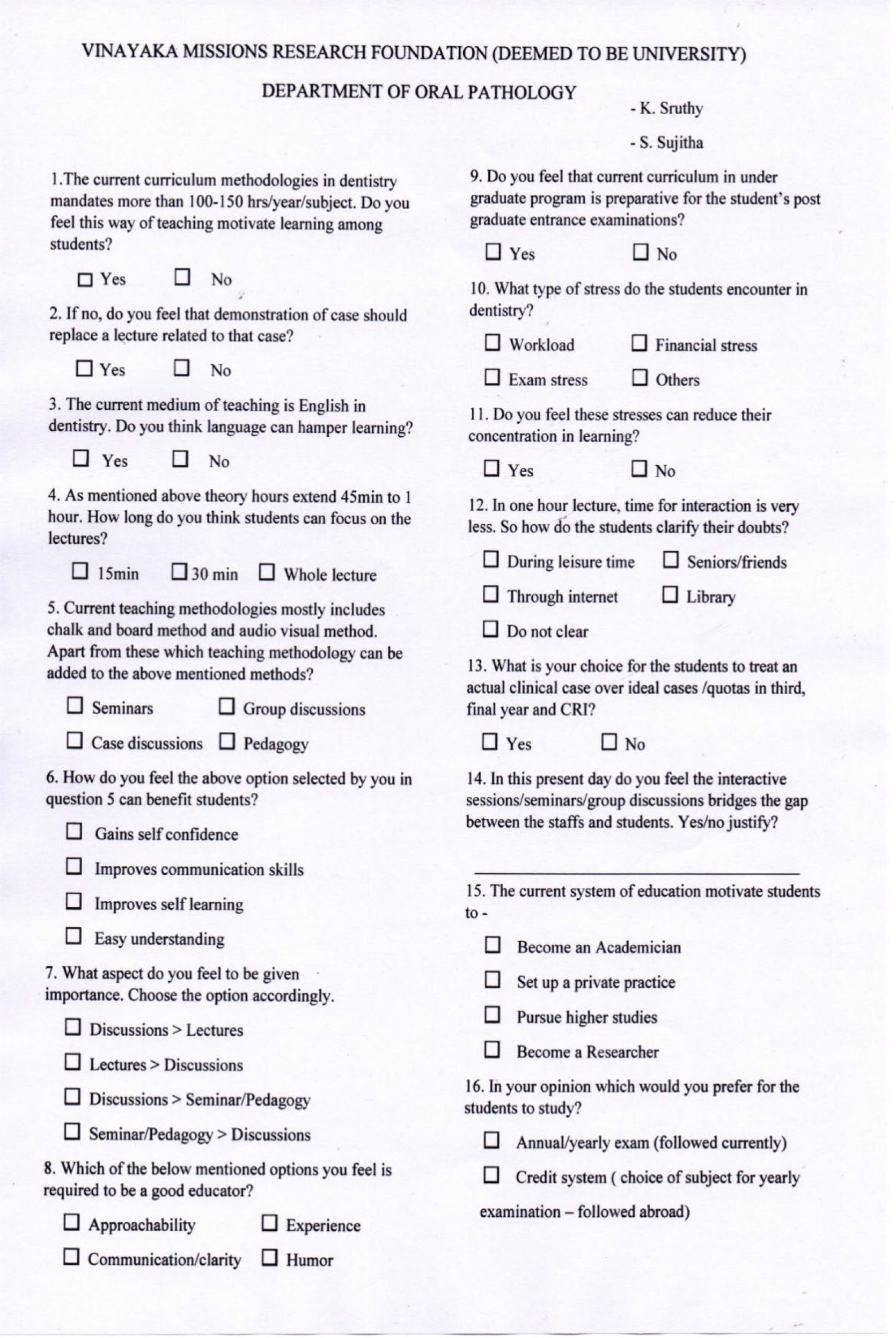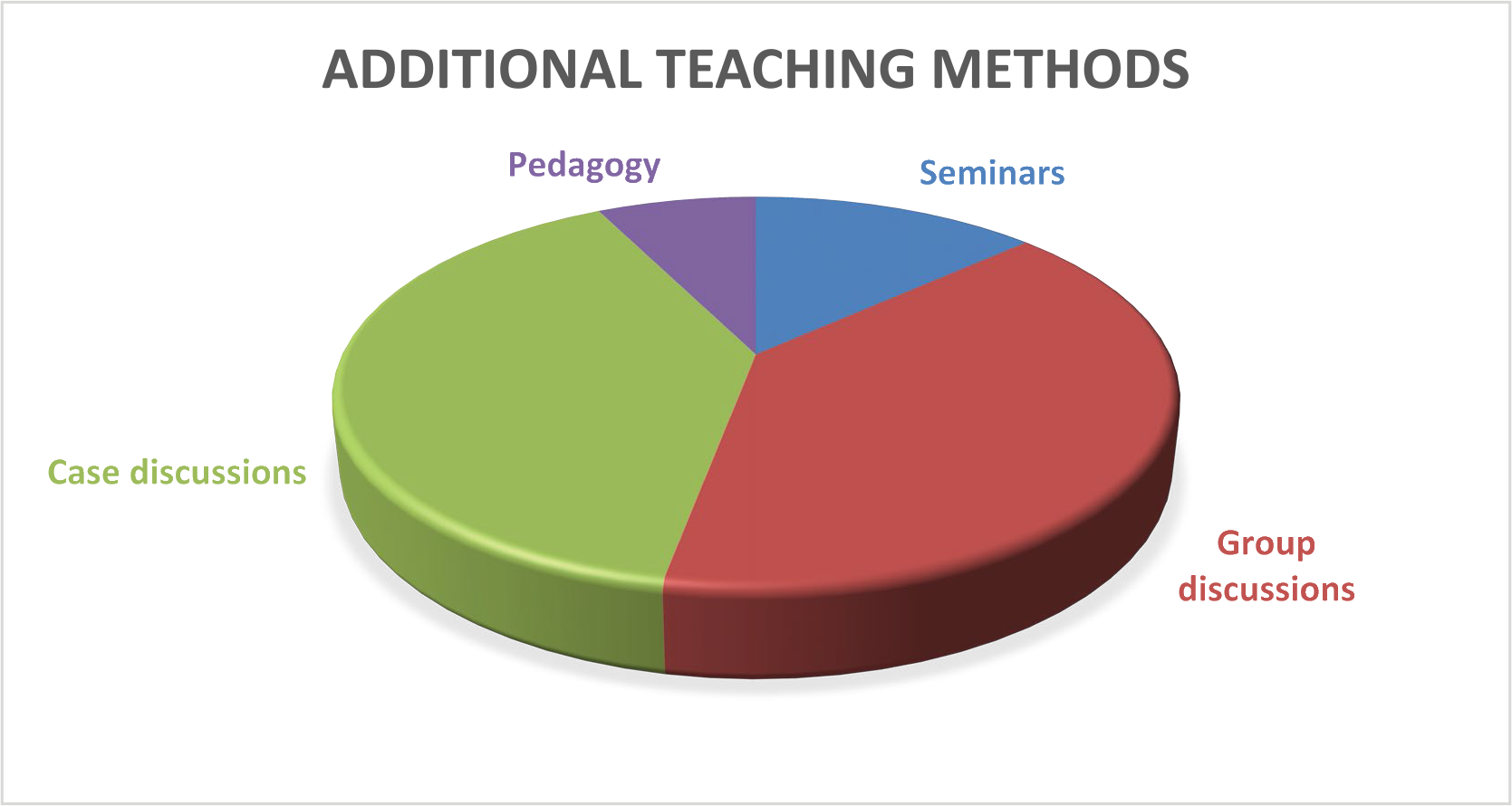Translate this page into:
Perspective of Teaching Methodologies in Dentistry: Active vs Passive Learning
*Address for correspondence:
This article was originally published by Informatics Publishing and was migrated to Scientific Scholar after the change of Publisher.
Abstract
Education in its general sense is a form of learning, in which knowledge, skills and habits are transferred across generations through teaching. The syllabus and curriculum followed by the dental colleges in training undergraduate and postgraduate students have been set by the Dental Council of India in assuring a minimum standard of quality. The current design of curriculum emphasizes on didactic lectures with inclusion of minimum quota completion as a prerequisite for the student to appear for university examinations. This article comprises of a questionnaire study on obtaining the perspective of teaching methodology in dentistry among staffs and students.
Keywords
Active Learning
Group Discussions
Lectures
Teaching Methodology
1. Introduction
Never stop learning because life never stops teaching. Education is the most powerful weapon which you can use to change the world. The quality of an education system can never exceed the quality of its teachers. The advancement seen in the contemporary world in technology, life sciences and medicine are proliferating at an exhilarating rate with the advent of the internet and its availability to everyone. Professional students everywhere are implicitly required to keep up to date to stay alert with developments in their respective fields. The same follows in dentistry, with increased awareness of dental health problems and aesthetics, students feel the pressure to be prepared with the latest innovations in dentistry. All these have driven students to a more applicative approach to learning and studying relying on information from resources such as the internet. Also the teachers are to use additional teaching methods like group discussions, case discussions, seminars etc. The students actively engage in these methods rather than the traditional lectures where they passively receive the information provided by the teacher1. The present study was conducted to evaluate the current teaching methodology among staff and students.
2. Aim
To identify the most commonly opted additional teaching method.
The benefits of additional teaching methods.
The benefits of current system of education.
3. Methodology
A total of 50 participants were included in the study. These were divided into two main study groups, one group comprising of staff and the other group of students from second year to interns. Each group comprised of 10 participants. Two sets of questionnaires were prepared for staff and students. The sample of questionnaires for students and staff are shown in Figure 1, 2. The participants were given twenty minutes to answer the questionnaire provided to them. The answers provided from the questionnaire are compiled in the tabular column are given in the Table 1.

- Questionnaire for staffs.

- Questionnaire for students.
| Q.No | Nature Of Question | Options | Percentage (%) |
|---|---|---|---|
| 1. | Teaching hours for motivated learning (100-150 hrs/subject) | Yes -23 No - 27 |
46 54 |
| 2. | Preference for demonstration to lectures | Yes - 30 No - 5 |
60 10 |
| 3. | English medium is satisfactory | Yes - 16 No - 34 |
32 68 |
| 4. | Attention span in an one hour lecture | 15 min - 9 30 min - 38 Whole lecture - 3 |
18 76 6 |
| 5. | Additional teaching methods to traditional methods | Seminars - 9 Group discussions - 27 Case discussions - 27 Pedagogy - 5 |
18 54 54 10 |
| 6. | Benefits acquired by teaching methodologies in option 5 | Gains self confidence - 11 Improves communication skills - 11 Improves self learning - 15 Easy understanding - 20 |
22 22 30 40 |
| 7. | Preference among teaching methods | Discussions > lectures - 32 Lectures > Discussions - 3 Discussions > seminars/ Pedagogy - 10 Seminars > discussions - 7 |
64 6 20 14 |
| 8. | Preferred quality of a educator | Approachability - 15 Experience - 7 Communication/ clarity - 34 Humor -4 |
30 14 68 8 |
| 9. | PG entrance exam preparations in UG curriculum | Yes - 25 No - 25 |
50 50 |
| 10. | Stress in dentistry | Workload - 28 Financial stress - 8 Exam stress - 7 Others - 12 |
56 16 14 24 |
| 11. | Influence of stress in concentration | Yes - 39 No - 11 |
78 22 |
| 12. | Clarification of doubts | During leisure time - 3 Seniors/friends - 21 Internet - 20 Library - 7 Do not clear - 5 |
6 42 40 14 10 |
4. Discussion
The present study was done to obtain the perspective of present day teaching methodologies and also the opinion of staffs regarding the teaching methodologies and its effectiveness in sharing knowledge and harnessing skills in dentistry based on our questionnaire.
According to DCI norms, each subject has approximately 100-150 hours per year. About half of the participants agree that this way of teaching do motivate students to learn and further refer textbooks. Most students felt that their concentration span for theory lectures is around 30 minutes.
Majority of staffs and students opted additional teaching methods like group discussions and case discussions (Figure 3) and the reasons given were that they felt they would attain a better understanding of the subjects and also boost their self confidence (Figure 4) in dealing with patients. Most of the participant’s opted interactive sessions bridge the gap between staffs and students but still half among them prefer to clarify their doubts with seniors/friends1–4.

- Additional teaching methods.

- Benefits of additional teaching methods.
The fact that English is the medium of study did not hamper the learning in any aspect shows that with increased exposure to internet students are able to quickly adapt to the language5.
The role of a teacher in the present day is not only teaching but also in motivating students in the particular subject. Among qualities that are required by an educator, students opted for communication or clarity of subject and approachability to clarify doubts.
With the introduction of screening or entrance exams in India to pursue a post-graduation, the staff felt that the current curriculum in under graduation is preparative for PG entrance examinations. Students on the other hand felt that the current system did prepare them for the abstract pattern of examination and did provide the necessary skills in the appearing for objective based questions particularly in time management for answering such questions.
As was expected students found that the stress of quotas coupled with the anxiety of examinations did affect them in performing to the best of their potential. Moreover demonstration of a clinical case with actual clinical setting or scenarios of managing patients were preferred over lectures (Figure 5). Students studying professional courses feel that lectures do not prepare them for managing actual patient-case scenario despite having case quotas in the all specialities. The bridge between theory and the practical classes is considered a formality or prerequisite for appearing examinations. The approach to studying dentistry would be more theoretical than practical or empirical2,3.

- Treating an actual case preferred to quota.
Majority of staff feels current system of education motivates students to pursue their higher studies while more number of students is motivated to become an academician or to set a private practice (Figure 6).

- Benefits of current education system.
Highest number of participants was satisfied with current annual/yearly system of education than following credit system2.
5. Conclusion
On analysing our questionnaire study, the current methodologies in teaching motivate the students in learning, but the acquiring of dental skills and clinical improvising is attained by exposure by an inquisitive approach to dental subjects. Current teaching methodologies include traditional chalk and board method with or without audio visual aids. Based on our survey, staff and students do believe that the theoretical or instructional training followed in the present generation is obsolete and need of the hour is to adopt a learning system to inculcate scientific attitude and reasoning towards dentistry.
References
- Learning by doing: An empirical study of active teaching techniques. The Journal of Effective Teaching. 2011;11(2):40-54.
- [Google Scholar]
- Dental clinical teaching: perceptions of students and teachers. Journal of Dental Education. 2005;69(12):1377-84.
- [PubMed] [Google Scholar]
- How effective the Problem Based Learning (PBL) in dental education. A critical review. The Saudi Dental Journal. 2016;28:155-61.
- [PubMed] [PubMed Central] [Google Scholar]
- Problem-based learning: Dental student’s perception of their education environments at Qassim University. Journal of International Society of Preventive and Community Dentistry. 2016;6(6):575-83.
- [PubMed] [PubMed Central] [Google Scholar]
- A systematic review on the most effective method teaching dentistry to dental students compared to video based learning. American Journal of Educational Research. 2017;5(1):63-8.
- [Google Scholar]






